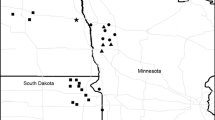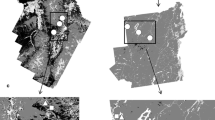Abstract
Understanding factors that influence changes in habitat occupancy of wetland fauna is important, particularly for species of conservation concern. One such species, the Swainson’s warbler (Limnothlypis swainsonii), breeds in bottomland hardwood forests in the southeastern U.S. Because these warblers nest in the shrub layer and forage in leaf litter, they may be negatively influenced by flood-induced changes to their habitat. In 2004, we repeated song-broadcast surveys and vegetation sampling at 42 locations that were occupied by Swainson’s warblers in 2000 or 2001 at four study sites in Arkansas. Only nine of 42 previously occupied locations (21%) were determined to be occupied 3–4 years after the original surveys. Occupancy changes were associated with decreases in depth and cover of leaf litter and shrub cover, and increases in cover of bare ground and forbs. These habitat and occupancy changes were associated with flooding that occurred between sample periods at three of four study sites, although detections declined at all four sites. Future conservation efforts for this species should focus on providing relatively high elevation areas that are typically free from the effects of periodic flooding.




Similar content being viewed by others
References
Anich NM, Benson TJ, Bednarz JC (2009) Estimating territory and home-range sizes: do singing locations alone provide an accurate estimate of space use? Auk 126:626–634
Bednarz JC, Stiller-Krehel P, Cannon B (2005) Distribution and habitat use of Swainson’s warblers in eastern and northern Arkansas. In: Ralph CJ, Rich TD (eds) Bird conservation implementation and integration in the Americas: Proceedings of the third international Partners in Flight conference, Volume 1, USDA Forest Service General Technical Report PSW-GTR-191 pp. 576–588
Benson TJ (2008) Habitat use and demography of Swainson’s warblers in eastern Arkansas. Dissertation, Arkansas State University
Benson TJ, Anich NM, Brown JD, Bednarz JC (2010) Habitat and landscape effects on brood parasitism, nest survival, and fledgling production in Swainson’s warblers. Journal of Wildlife Management 74:73–85
Brawn JD, Robinson SK, Thompson FR III (2001) The role of disturbance in the ecology and conservation of birds. Annual Review of Ecology and Systematics 32:251–276
Brown JD, Benson TJ, Bednarz JC (2009) Vegetation characteristics of Swainson’s warbler habitat at the white river national wildlife refuge, Arkansas. Wetlands 29:586–597
Brown RE, Dickson JG (1994) Swainson’s warbler (Limnothlypis swainsonii). In: Poole A, Gill F (eds) The birds of North America, No. 126. The Birds of North America, Inc., Philadelphia, pp. 1–19
Christman SP (1984) Breeding bird response to greentree reservoir management. Journal of Wildlife Management 48:1164–1172
Cody ML (ed) (1985) Habitat selection in birds. Academic, New York
Dynesius M, Nilsson C (1994) Fragmentation and flow regulation of river systems in the northern third of the world. Science 266:753–762
Eddleman WR, Evans KE, Elder WH (1980) Habitat characteristics and management of Swainson’s warbler in southern Illinois. Wildlife Society Bulletin 8:228–233
Gagnon PR (2009) Fire in floodplain forests in the southeastern USA: insights from disturbance ecology of native bamboo. Wetlands 29:520–526
Graves GR (2001) Factors governing the distribution of Swainson’s warbler along a hydrological gradient in Great Dismal Swamp. Auk 118:650–664
Graves GR (2002) Habitat characteristics in the core breeding range of the Swainson’s warbler. Wilson Bulletin 114:210–220
Hagan JM III, Johnston DW (eds) (1992) Ecology and conservation of Neotropical migrant landbirds. Smithsonian Institution, Washington, DC
Hetzel JM, Leberg PL (2006) Effects of selective logging on breeding bird communities in bottomland hardwood forests in Louisiana. Journal of Wildlife Management 70:1416–1424
Hunter WC, Anderson BW, Ohmart RD (1987) Avian community structure changes in a mature floodplain forest after extensive flooding. Journal of Wildlife Management 51:495–502
Hunter WC, Pashley DN, Escano REF (1993) Neotropical migratory landbird species and their habitats of special concern within the Southeast region. In: Finch DM, Stangel PW (eds) Status and management of Neotropical migratory birds, USDA Forest Service General Technical Report RM-229, pp. 159–169
Jones RH, Sharitz RR, Dixon PM, Segal DS, Schneider RL (1994) Woody plant regeneration in four floodplain forests. Ecological Monographs 64:345–367
Klaus NA (2004) Swainson’s warblers may shift territories in response to spring flooding. Oriole 69:19
Knopf FL, Sedgwick JA (1987) Latent population responses of summer birds to a catastrophic, climatological event. Condor 89:869–873
Knutson MG, Klaas EE (1997) Declines in abundance and species richness of birds following a major flood on the Upper Mississippi River. Auk 114:367–380
Littell RC, Milliken GA, Stroup WW, Wolfinger RD, Schabenberger O (2006) SAS for mixed models. SAS Institute, Cary
Martin TE, Paine CR, Conway CJ, Hochachka WM, Allen P, Jenkins W (1997) BBIRD Field Protocol. Montana Cooperative Wildlife Research Unit. University of Montana, Missoula
Meanley B (1966) Some observations on habitats of the Swainson’s warbler. Living Bird 5:151–165
Meanley B (1971) Natural history of the Swainson’s warbler. U.S. Department of the Interior. North American Fauna No. 69. Washington, DC
Rich TD, Beardmore CJ, Berlanga H, Blancher PJ, Bradstreet MSW, Butcher GS, Demarest DW, Dunn EH, Hunter WC, Inigo-Elias EE, Kennedy JA, Martell AM, Panjabi AO, Pashley DN, Rosenberg KV, Rustay CM, Wendt JS, Will TC (2004) Partners in flight North American landbird conservation plan. Cornell Laboratory of Ornithology, Ithaca
Rudis VA (1995) Regional forest fragmentation effects on bottomland hardwood community types and resource values. Landscape Ecology 10:291–307
Sallabanks R, Walters JR, Collazo JA (2000) Breeding bird abundance in bottomland hardwood forests: habitat, edge, and patch size effects. Condor 102:748–758
SAS Institute (2004) SAS/STAT 9.1 user’s guide. SAS Institute Inc., Cary, NC
Somershoe SG, Hudman SP, Chandler CR (2003) Habitat use by Swainson’s warblers in a managed bottomland forest. Wilson Bulletin 115:148–154
Sparks RE, Nelson JC, Yin Y (1998) Naturalization of the flood regime in regulated rivers. BioScience 48:706–720
Sparks RE, Spink A (1998) Disturbance, succession and ecosystem processes in rivers and estuaries: effects of extreme hydrologic events. Regul Rivers: Research and Management 14:155–159
Twedt DJ, Loesch CR (1999) Forest area and distribution in the Mississippi Alluvial Valley: implications for breeding bird conservation. Journal of Biogeography 26:1215–1224
Twedt DJ, Uihlein WB, Elliott AB (2006) A spatially explicit decision support model for restoration of forest bird habitat. Conservation Biology 20:100–110
Twedt DJ, Wilson RR (2007) Management of bottomland hardwood forests for birds. In: Shupe TF (ed) Proceedings of the Louisiana natural resources symposium. Louisiana State University, Baton Rouge, pp 49–64
U.S. Army Corps of Engineers (2008) RiverGages.com: Water levels of rivers and lakes. Available via http://www2.mvr.usace.army.mil/WaterControl/new/layout.cfm. Accessed 22 Aug 2009
U.S. Fish and Wildlife Service (2002) Birds of conservation concern 2002. Division of Migratory Bird Management, Arlington
U.S. Geological Survey (2008) National Water Information System (NWISWeb). Available via http://waterdata.usgs.gov/nwis/. Accessed 22 Aug 2009
Wakely JS, Roberts TH (1996) Bird distributions and forest zonation in a bottomland hardwood wetland. Wetlands 16:296–308
Winker K, Graves GR, Braun MJ (2000) Genetic differentiation among populations of a migratory songbird: Limnothlypis swainsonii. Journal of Avian Biology 31:319–328
Yin Y (1998) Flooding and forest succession in a modified stretch along the Upper Mississippi River. Regul Rivers: Research and Management 14:217–225
Acknowledgments
Funding for this research was provided by the Arkansas Game and Fish Commission (AGFC) and U.S. Fish and Wildlife Service (USFWS) through a State Wildlife Grant and a separate grant from the AGFC. We thank L. Barnhill and C. Rideout, formerly of AGFC, for continued support of this research. R. Hines of the USFWS and C. Bitting of the National Park Service provided invaluable assistance. We thank J. Brown, D. Baxter, B. Blakely, B. Cannon, S. Fowler, J. Jackson, P. Stiller-Krehel, J. Millikin, A. St.-Pierre, and D. Townsend for valuable field assistance. S. Somershoe, W. Barrow, D. Dobkin, an anonymous reviewer, and members of the Avian Ecology Lab at Arkansas State University provided helpful comments on a previous version of this manuscript.
Author information
Authors and Affiliations
Corresponding author
Rights and permissions
About this article
Cite this article
Benson, T.J., Bednarz, J.C. Short-Term Effects of Flooding on Understory Habitat and Presence of Swainson’s Warblers. Wetlands 30, 29–37 (2010). https://doi.org/10.1007/s13157-009-0004-3
Received:
Accepted:
Published:
Issue Date:
DOI: https://doi.org/10.1007/s13157-009-0004-3




